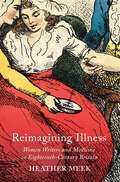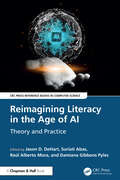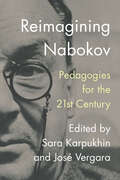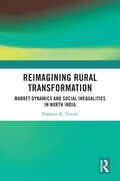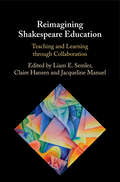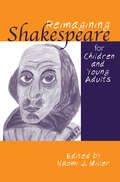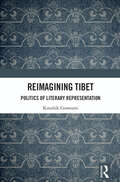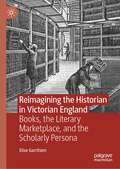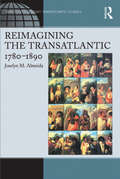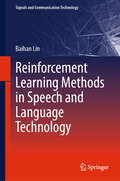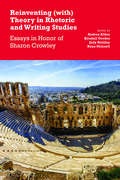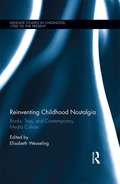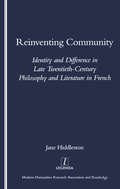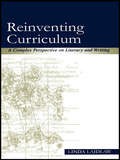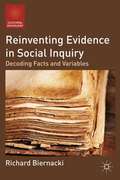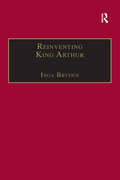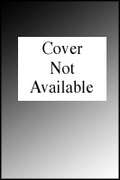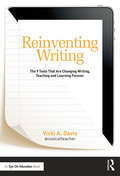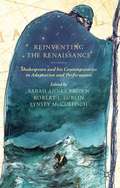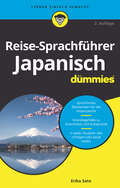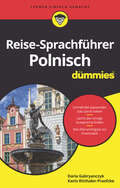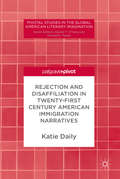- Table View
- List View
Reimagining Illness: Women Writers and Medicine in Eighteenth-Century Britain (McGill-Queen's/AMS Healthcare Studies in the History of Medicine, Health, and Society)
by Heather MeekIn eighteenth-century Britain the worlds of literature and medicine were closely intertwined, and a diverse group of people participated in the circulation of medical knowledge. In this pre-professionalized milieu, several women writers made important contributions by describing a range of common yet often devastating illnesses.In Reimagining Illness Heather Meek reads works by six major eighteenth-century women writers – Jane Barker, Anne Finch, Lady Mary Wortley Montagu, Hester Lynch Thrale Piozzi, Mary Wollstonecraft, and Frances Burney – alongside contemporaneous medical texts to explore conditions such as hysteria, melancholy, smallpox, maternity, consumption, and breast cancer. In novels, poems, letters, and journals, these writers drew on their learning and literary skill as they engaged with and revised male-dominated medical discourse. Their works provide insight into the experience of suffering and interrogate accepted theories of women’s bodies and minds. In ways relevant both then and now, these women demonstrate how illness might be at once a bodily condition and a malleable construct full of ideological meaning and imaginative possibility.Reimagining Illness offers a new account of the vital period in medico-literary history between 1660 and 1815, revealing how the works of women writers not only represented the medicine of their time but also contributed meaningfully to its developments.
Reimagining Literacy in the Age of AI: Theory and Practice (CRC Press Reference Books in Computer Science)
by Raúl Alberto Mora Damiana Gibbons Pyles Jason D. DeHart Suriati AbasThis volume assesses the critical intersection of artificial intelligence (AI) and literacy education. Drawing on the concept of "living literacies," it explores the transformative potential of AI in literacy practices, offering a comprehensive narrative that bridges theoretical frameworks with practical applications.The book goes beyond the conventional understanding of AI literacy as mere technological proficiency. Instead, it positions AI as a catalyst for expansive, inclusive, and multifaceted literacy practices in the digital age. Scholars from different parts of the world examine how AI is not just changing what we read and write but how we think, create, and express ourselves in a post-human context.KEY FEATURES Explores AI literacy that encompasses critical thinking, ethical reasoning, and creative expression Offers insights into the role of educators and researchers in cultivating AI literacy among learners Discusses how creativity and identity intertwine with AI literacy Suggests practical approaches to integrating AI into classroom instruction across different age groups This timely work serves as an essential guide for educators, researchers, and learners by navigating the evolving terrain of literacy in a world increasingly augmented by AI.
Reimagining Nabokov: Pedagogies for the 21st Century
by José Vergara Sara KarpukhinIn Reimagining Nabokov: Pedagogies for the 21st Century, eleven teachers of Vladimir Nabokov describe how and why they teach this notoriously difficult, even problematic, writer to the next generations of students. Contributors offer fresh perspectives and embrace emergent pedagogical methods, detailing how developments in technology, translation and archival studies, and new interpretative models have helped them to address urgent questions of power, authority, and identity. Practical and insightful, this volume features exciting methods through which to reimagine the literature classroom as one of shared agency between students, instructors, and the authors they read together. “It is both timely and refreshing to have an influx of teacher-scholars who engage Nabokov from a variety of perspectives… this volume does justice to the breadth of Nabokov’s literary achievements, and it does so with both pedagogical creativity and scholarly integrity” • Dana Dragunoiu, Carleton University "[A] valuable study for any reader, teacher, scholar, or student of Nabokov. Amongst specific and urgent insights on the potential for digital methods, the relevance of Nabokov for students today, and how to reconcile issues of identity with an author who disavowed history and politics, are much wider and timeless questions of authorial control and the ability to access reality."—Anoushka Alexander-Rose, Nabokov Online Journal Contributions by Galya Diment, Tim Harte, Robyn Jensen, Sara Karpukhin, Yuri Leving, Roman Utkin, José Vergara, Meghan Vicks, Olga Voronina, Lisa Ryoko Wakamiya, and Matthew Walker.
Reimagining Public Service Media: Navigating Change and Exploring Public Consensus in the Czech Republic (Routledge Focus on Communication and Society)
by Marína Urbániková Klára Smejkal Iveta Jansová Lenka Waschková CísařováIncorporating perspectives of various key stakeholders, this book critically explores the state and future of public service media (PSM), and maps areas of consensus upon which a renewed social contract for PSM could be built.Broadening the debate beyond normative frameworks and drawing on perspectives other than elite and expert opinions, this book represents a vital contribution to the discussion over PSM’s present and future. The study uses the Czech Republic as a case study, a representative Central and Eastern European (CEE) country that, following the fall of its Communist regime, successfully transformed its former state-run media propaganda system into PSM. Employing a mixed-methods research design, it provides empirically-based insights from three groups, namely: the general public, PSM’s audience and source of funding; politicians and members of PSM supervisory bodies; and PSM journalists and managers. This book synthesises the perspectives of these three groups, focusing on the common ground in their expectations and evaluations, and exploring where the societal consensus lies in terms of the public service PSM should provide and the public value it should bring. The analysis pays particular attention to the unique position of PSM in smaller countries and within the CEE region.Reimagining Public Service Media is recommended reading for advanced students and researchers in fields including Media Ownership, Media Regulation, and Media and Politics.
Reimagining Rural Transformation: Market Dynamics and Social Inequalities in North India
by Prashant K TrivediThis book examines the effects of the pattern of growing integration between the rural and urban economies in India. Drawing on in-depth surveys conducted in villages in north India, it examines the rural agricultural economy's transformation, productivity, technology deployment, and social relations over a period of seven years. The book focuses on the socially embedded nature of the dynamics of transformation, weaving analysis around the axis of land, caste, and gender. It also identifies policy gaps and recommends steps for a sustainable and inclusive rural transformation in the Global South.An important contribution to the study of India’s economic and social landscape, this book will be useful for scholars of agriculture, sociology, economics, political science, development studies, and South Asian studies. It will also be of interest to policymakers and journalists interested in rural development, migration, employment, agriculture, and demography.
Reimagining Shakespeare Education: Teaching and Learning through Collaboration
by Liam E. Semler Claire Hansen Jacqueline ManuelShakespeare education is being reimagined around the world. This book delves into the important role of collaborative projects in this extraordinary transformation. Over twenty innovative Shakespeare partnerships from the UK, US, Australia, New Zealand, the Middle East, Europe and South America are critically explored by their leaders and participants. –Structured into thematic sections covering engagement with schools, universities, the public, the digital and performance, the chapters offer vivid insights into what it means to teach, learn and experience Shakespeare in collaboration with others. Diversity, equality, identity, incarceration, disability, community and culture are key factors in these initiatives, which together reveal how complex and humane Shakespeare education can be. Whether you are interested in practice or theory, this collection showcases an abundance of rich, inspiring and informative perspectives on Shakespeare education in our contemporary world.
Reimagining Shakespeare for Children and Young Adults (Children's Literature and Culture)
by Naomi MillerFirst published in 2003. Routledge is an imprint of Taylor & Francis, an informa company.
Reimagining Society in 18th Century French Literature: Happiness and Human Rights (Routledge Studies in Eighteenth-Century Literature)
by Jonas Ross KjærgårdThe French revolutionary shift from monarchical to popular sovereignty came clothed in a new political language, a significant part of which was a strange coupling of happiness and rights. In Old Regime ideology, Frenchmen were considered subjects who had no need of understanding why what was prescribed to them would be in the interest of their happiness. The 1789 Declaration of the Rights of Man and of the Citizen equipped the French with a list of inalienable rights and if society would respect those rights, the happiness of all would materialize. This volume explores the authors of fictional literature who contributed alongside pamphleteers, politicians, and philosophers to the establishment of this new political arena, filled with sometimes vague, yet insisting notions of happiness and rights. The shift from monarchical to popular sovereignty and the corollary transition from subjects to citizens culminated in the summer of 1789 but it was preceded by an immense piece of imaginative work.
Reimagining Tibet: Politics of Literary Representation
by Koushik GoswamiThis book examines how territorial, civilisational and cultural location determines one’s gaze and attitude while representing a contested space like Tibet. It analyses representations of Tibet in three novels: James Hilton’s Lost Horizon (1933), Jamyang Norbu’s The Mandala of Sherlock Holmes (1999) and Kaushik Barua’s Windhorse (2013). It shows how these novels project different types of gaze — insider, outsider and insider-outsider — and explores them within the context of some contemporary Tibetan activist writers. The book also looks at Tibetan exilic writings and virtual activities of the Tibetan activists whose programmes and rhetoric counter the age-old image of the Tibetans as passive and non-violent people. It shows how activists utilise social networking as an effective platform to counter imperialist occupation of Tibet by China. It includes interviews of eight Anglophone Tibetan writers – Tenzin Tsundue, Thubten Samphel, Tsering Namgyal Khortsa, Tsering Wangmo Dhompa, Jamyang Norbu, Tenzin Dickie, Bhuchung D. Sonam, and an Indian writer who has written on Tibet, Kaushik Barua. Interdisciplinary, accessible and engaging, this book presents one of the first studies on how Tibet has been represented in English fiction. It will be of interest to scholars and researchers of literature, media and cultural studies, politics, history and China studies.
Reimagining the Historian in Victorian England: Books, the Literary Marketplace, and the Scholarly Persona
by Elise GarritzenThis book traces the transformation of history from a Romantic literary pursuit into a modern academic discipline during the second half of the nineteenth century, and shows how this change inspired Victorians to reconsider what it meant to be a historian. This reconceptualization of the ‘historian’ lies at the heart of this book as it explores how historians strove to forge themselves a collective scholarly persona that reflected and legitimised their new disciplinary status and gave them authority to speak on behalf of the past. The author argues that historians used the persona as a replacement for missing institutional structures, and converted book parts to a sphere where they could mould and perform their persona. By ascribing agency to titles, footnotes, running heads, typography, cover design, size, and other paratexts, the book makes an important shift in the way we perceive the formation of modern disciplines. By combining the persona and paratexts, it offers a novel approach to themes that have enjoyed great interest in the history of science. It examines, for example, the role which epistemic and moral virtues held in the Victorian society and scholarly culture, the social organization and hierarchies of scholarly communities, the management of scholarly reputations, the commercialization of knowledge, and the relationship between the persona and the underpinning social, political, economic, and cultural structures and hierarchies. Making a significant contribution to persona studies, it provides new insights for scholars interested in the history of humanities, science, and knowledge; book history; and Victorian culture.
Reimagining the Transatlantic, 1780-1890 (Ashgate Series In Nineteenth-century Transatlantic Studies)
by Joselyn M. AlmeidaIn her thought-provoking study of Britain's relationship with Latin America and the Caribbean during the Romantic and Victorian periods, Joselyn M. Almeida makes a compelling case for extending the critical boundaries of current transatlantic and circumatlantic scholarship. She proposes the pan-Atlantic as a critical model that encompasses Britain's relationship to the non-Anglophone Americas given their shared history of conquest and the slave trade, and underscores the importance of writings by Afro-British and Afro-Hispanophone authors in formulating Atlantic culture. In adopting the term pan-Atlantic, Almeida argues for the interrelationship of the discourses of discovery, conquest, enslavement, and liberation expressed in literary motifs such as the New World, Columbus, and Las Casas; the representation of Native Americans; the enslavement and liberation of Africans; and the emancipation of Spanish America. Her study draws on the works of William Robertson, Ottobah Cugoano, Francisco Clavijero, Francisco Miranda, José Blanco White, Richard Robert Madden, Juan Manzano, Charles Darwin, and W. H. Hudson, uncovering the shared cultural grammar of travel narratives, abolitionist poems, novels, and historiographies that crosses national and linguistic boundaries.
Reinforcement Learning Methods in Speech and Language Technology (Signals and Communication Technology)
by Baihan LinThis book offers a comprehensive guide to reinforcement learning (RL) and bandits methods, specifically tailored for advancements in speech and language technology. Starting with a foundational overview of RL and bandit methods, the book dives into their practical applications across a wide array of speech and language tasks. Readers will gain insights into how these methods shape solutions in automatic speech recognition (ASR), speaker recognition, diarization, spoken and natural language understanding (SLU/NLU), text-to-speech (TTS) synthesis, natural language generation (NLG), and conversational recommendation systems (CRS). Further, the book delves into cutting-edge developments in large language models (LLMs) and discusses the latest strategies in RL, highlighting the emerging fields of multi-agent systems and transfer learning. Emphasizing real-world applications, the book provides clear, step-by-step guidance on employing RL and bandit methods to address challenges in speech and language technology. It includes case studies and practical tips that equip readers to apply these methods to their own projects. As a timely and crucial resource, this book is ideal for speech and language researchers, engineers, students, and practitioners eager to enhance the performance of speech and language systems and to innovate with new interactive learning paradigms from an interface design perspective.
Reinventing (with) Theory in Rhetoric and Writing Studies: Essays in Honor of Sharon Crowley
by Andrea Alden Kendall Gerdes Judy Holiday Ryan SkinnellReinventing (with) Theory in Rhetoric and Writing Studies collects original scholarship that takes up and extends the practices of inventive theorizing that characterize Sharon Crowley’s body of work. Including sixteen chapters by established and emerging scholars and an interview with Crowley, the book shows that doing theory is a contingent and continual rhetorical process that is indispensable for understanding situations and their potential significance—and for discovering the available means of persuasion. For Crowley, theory is a basic building block of rhetoric “produced by and within specific times and locations as a means of opening other ways of believing or acting.” Doing theory, in this sense, is the practice of surveying the common sense of the community (doxa) and discovering the available means of persuasion (invention). The ultimate goal of doing theory is not to prescribe certain actions but to ascertain what options exist for rhetors to see the world differently, to discover new possibilities for thought and action, and thereby to effect change in the world. The scholarship collected in Reinventing (with) Theory in Rhetoric and Writing Studies takes Crowley’s notion of theory as an invitation to develop new avenues for believing and acting. By reinventing the understanding of theory and its role in the field, this collection makes an important contribution to scholarship in rhetorical studies and writing studies. It will be valuable to scholars, teachers, and students interested in diverse theoretical directions in rhetoric and writing studies as well as in race, gender, and disability theories, religious rhetorics, digital rhetoric, and the history of rhetoric. Publication supported in part by the Texas Tech University Humanities Center. Contributors: Jason Barrett-Fox, Geoffrey Clegg, Kirsti Cole, Joshua Daniel-Wariya, Diane Davis, Rebecca Disrud, Bre Garrett, Catherine C. Gouge, Debra Hawhee, Matthew Heard, Joshua C. Hilst, David G. Holmes, Bruce Horner, William B. Lalicker, Jennifer Lin LeMesurier, James C. McDonald, Timothy Oleksiak, Dawn Penich-Thacker, J. Blake Scott, Victor J. Vitanza, Susan Wyche
Reinventing Childhood Nostalgia: Books, Toys, and Contemporary Media Culture (Studies in Childhood, 1700 to the Present)
by Elisabeth WesselingWhile Romantic-era concepts of childhood nostalgia have been understood as the desire to retrieve the ephemeral mindset of the child, this collection proposes that the emergence of digital media has altered this reflective gesture towards the past. No longer is childhood nostalgia reliant on individual memory. Rather, it is associated through contemporary convergence culture with the commodities of one's youth as they are recycled from one media platform to another. Essays in the volume's first section identify recurrent patterns in the recycling, adaptation, and remediation of children's toys and media, providing context for section two's exploration of childhood nostalgia in memorial practices. In these essays, the contributors suggest that childhood toys and media play a role in the construction of s the imagined communities (Benedict Anderson) that define nations and nationalism. Eschewing the dichotomy between restorative and reflexive nostalgia, the essays in section three address the ethics of nostalgia in terms of child agency and depictions of childhood. In a departure from the notion that childhood nostalgia is the exclusive prerogative of narrative fiction, section four looks for its traces in the child sciences. Pushing against nostalgia's persistent associations with wishful thinking, false memories, and distortion, this collection suggests nostalgia is never categorically good or bad in itself, but owes its benefits or defects to the ways in which it is brought to bear on the representation of children and childhood.
Reinventing Community: Identity and Difference in Late Twentieth-century Philosophy and Literature in French
by Jane Hiddlestone"During recent years critics have increasingly expressed their loss of faith in existing cultural and political collective frameworks, drawing attention instead to irreducible singularity and to radical incommensurability between diverse positions or groups. Hiddleston analyses and challenges this trend, bringing together political, theoretical and literary analysis and juxtaposing the works of critical theorists such as Derrida, Lyotard and Nancy with literature by writers of North African immigrant origin. She presents a critique of those writers who underline the absence of communal identification, proposes a new emphasis on relational networks interconnecting diverse cultural groups, and argues for a more subtle understanding of the complex interplay of the singular and the collective in contemporary French writing."
Reinventing Curriculum: A Complex Perspective on Literacy and Writing
by Linda LaidlawIn this book, Linda Laidlaw explores the questions: What happens when children begin to write? Why is it that the teaching and practice of writing seems at times to be difficult in schools? How might teachers work differently to create more inviting spaces for developing literacy? The premise is that written texts and literacy processes are developed within a complex "weave" of particular contexts, or ecologies, and the unique particularity of the learner's experiences, histories, memories and interpretations. Laidlaw offers new information about writing and literacy pedagogy linked to current research in the complexity sciences and cognition, and considers the possibilities that might emerge for pedagogy when alternative metaphors, images, and structures are considered for writing and curriculum. The volume includes qualitative and narrative description of writing and literacy situations, events, and pedagogy, and elaborates the historical, theoretical, and curricular background in which such instruction exists within contemporary schooling.Reinventing Curriculum: A Complex-Perspective on Literacy and Writing:*addresses literacy through a focus on writing rather than on reading;*develops an approach to literacy and writing pedagogy that incorporates recent theories and research on learning and the complexity sciences;*examines perspectives on writing from both a teaching perspective and that of the work of writers;*makes connections between the acquisition of literacy to research in other domains;*examines both the benefits and the "costs" of literacy; and*challenges "commonsense" understandings within instruction, for example, that literacy teaching and learning can occur apart from other aspects of children's learning, context, and subjectivity, or that learning occurs individually rather than collectively.This book is important reading for researchers, professionals, teacher educators, and students involved in literacy education and writing instruction, and an excellent text for courses in these areas.
Reinventing Evidence In Social Inquiry
by Richard BiernackiRevisiting the dominant scientific method, 'coding,' with which investigators from sociology to literary criticism have sampled texts and catalogued their cultural messages, the author demonstrates that the celebrated hard outputs rest on misleading samples and on unfeasible classifying of the texts' meanings.
Reinventing King Arthur: The Arthurian Legends in Victorian Culture (The Nineteenth Century Series)
by Inga BrydenIn her systematic reassessment of the remaking of the Arthurian past in nineteenth-century British fiction and non-fiction, Inga Bryden examines the Victorian Arthurian revival as a cultural phenomenon, offering insights into the relationship between social, cultural, religious, and ethnographic debates of the period and a wide range of texts. Throughout, she adopts an intertextual and historical perspective, informed by poststructuralist thinking, to reveal nineteenth-century attitudes towards the past. Starting with a review of the historical evidence available to Victorian writers and an examination of how historians of the time represented Arthur, the author connects Victorian accounts of Arthur's quest to contemporary scientific and historical searches for origins and knowledge, and to his appropriation by competing religious movements. She shows how writers explored the dynamics of heroism by recruiting Arthur and his knights to define codes of chivalric service, and to personify the psychological complexities of love. Finally, the legend of his death and transportation to Avalon is deconstructed and placed in the context of cultural attitudes towards commemorating the dead and theological debates about the afterlife. Inga Bryden engages not only with well-known Arthurian texts by Tennyson, Swinburne, Morris and Rossetti, but with lesser-known works by Bulwer-Lytton, Robert Stephen Hawker, Sebastian Evans, Diana Maria Mulock, Christiana Douglas and Joseph Shorthouse.
Reinventing Shakespeare: A Cultural History, from the Restoration to the Present
by Gary TaylorRelates the various interpretations of Shakespeare's plays to the concerns and values of the particular era, and uses the contrasts to examine the bases of aesthetic judgment.
Reinventing World War II: Popular Memory in the Rise of the Ethnonationalist State (RSA Series in Transdisciplinary Rhetoric)
by Barbara A. BieseckerBy the 1970s, World War II had all but disappeared from US popular culture. But beginning in the mid-eighties it reemerged with a vengeance, and for nearly fifteen years World War II was ubiquitous across US popular and political culture. In this book, Barbara A. Biesecker explores the prestige and rhetorical power of the “Good War,” revealing how it was retooled to restore a new kind of social equilibrium to the United States.Biesecker analyzes prominent cases of World War II remembrance, including the canceled exhibit of the Enola Gay at the National Air and Space Museum in 1995 and its replacement, Steven Spielberg’s Saving Private Ryan, Tom Brokaw’s The Greatest Generation, and the United States Holocaust Memorial Museum. Situating these popular memory texts within the culture and history wars of the day and the broader framework of US political and economic life, Biesecker argues that, with the notable exception of the Holocaust Memorial Museum, these reinventions of the Good War worked rhetorically to restore a strong sense of national identity and belonging fitted to the neoliberal nationalist agenda.By tracing the links between the popular retooling of World War II and the national state fantasy, and by putting the lessons of Foucault, Derrida, Lacan, and their successors to work for a rhetorical-political analysis of the present, Biesecker not only explains the emergence and strength of the MAGA movement but also calls attention to the power of public memory to shape and contest ethnonational identity today. This book will interest rhetoricians and historians as well as students and scholars in the fields of US politics and communication studies.
Reinventing Writing: The 9 Tools That Are Changing Writing, Teaching, and Learning Forever
by Vicki DavisIn this much-anticipated book from acclaimed blogger Vicki Davis (Cool Cat Teacher), you’ll learn the key shifts in writing instruction necessary to move students forward in today’s world. Vicki describes how the elements of traditional writing are being reinvented with cloud-based tools. Instead of paper, note taking, filing cabinets, word processors, and group reports, we now have tools like ePaper, eBooks, social bookmarking, cloud syncing, infographics, and more. Vicki shows you how to select the right tool, set it up quickly, and prevent common mistakes. She also helps you teach digital citizenship and offers exciting ways to build writing communities where students love to learn. Special Features:• Essential questions at the start of each chapter to get you thinking about the big ideas• A chapter on each of the nine essential cloud-based tools--ePaper and eBooks; digital notebooks; social bookmarking; cloud syncing; cloud writing apps; blogging and microblogging; wikis and website builders; online graphic organizers and mind maps; and cartoons and infographics• A wide variety of practical ways to use each tool in the classroom• Alignments to the Common Core State Standards in writing • Level Up Learning--a special section at the end of each chapter to help you review, reflect on, and apply what you’ve learned• Writing tips to help you make the best use of the tools and avoid common pitfalls• A glossary of key terms discussed in the book• Useful appendices, including reproducible material for your classroom No matter what grade level you teach or how much tech experience you have, you will benefit from Vicki’s compelling and practical ideas. As she emphasizes throughout this essential book, teaching with cloud-based tools has never been easier, more convenient, or more important than right now.
Reinventing the Renaissance
by Sarah Annes Brown Robert I. Lublin Lynsey MccullochThe plays of Shakespeare and his contemporaries has inspired interpretations in every genre and medium. This book offers perspectives on the ways in which practitioners have used Renaissance drama to address contemporary concerns and reach new audiences. It provides a resource for those interested in the creative reception of Renaissance drama.
Reise-Sprachführer Japanisch für Dummies (Für Dummies)
by Eriko SatoMit diesem Büchlein sind Sie für die nächste Reise nach Japan gerüstet. Ob Sie in Tokio in einer Shopping Mall einkaufen, in Kyoto in einer Bar Sushi bestellen oder in Osaka über das Wetter plaudern: Hier finden Sie die passenden Sätze für die jeweilige Situation. Ganz nebenbei erfahren Sie das Wichtigste über die japanische Grammatik und bekommen viele Tipps für die richtige Aussprache.
Reise-Sprachführer Polnisch für Dummies (Für Dummies)
by Daria GabryanczykDer "Reise-Sprachführer Polnisch für Dummies" bietet einen schnellen à berblick über die wichtigsten Wörter und Redewendungen für den Reise-Alltag. Jedes Kapitel beschäftigt sich mit einer typischen Situation. So haben Sie schnell die passenden Sätze parat, wenn Sie sich beispielsweise jemandem vorstellen, im Restaurant bestellen oder nach einer Wegbeschreibung fragen. Dazu bekommen Sie eine kurze Einführung in die Grammatik und Aussprache des Polnischen.
Rejection and Disaffiliation in Twenty-First Century American Immigration Narratives (Pivotal Studies in the Global American Literary Imagination)
by Katie DailyRejection and Disaffiliation in Twenty-First Century American Immigration Narratives examines changing attitudes about national sovereignty and affiliation. Katie Daily delinks twenty-first century American immigration narratives from 9/11, examining genre alterations within a scope of literary analysis that is wider than what “post-9/11” allows. What emerges is an understanding of the speed at which the rhetoric and aims of many twenty-first century immigration narratives significantly depart from the traditions established post-1900. Daily investigates a recent trend in which novelists and filmmakers question what it means to be an immigrant in contemporary America and explores how these “disaffiliation” narratives challenge some of the most fundamental traditions in American literature and society.
